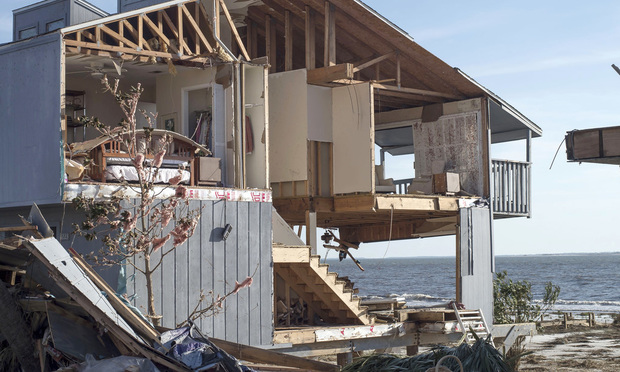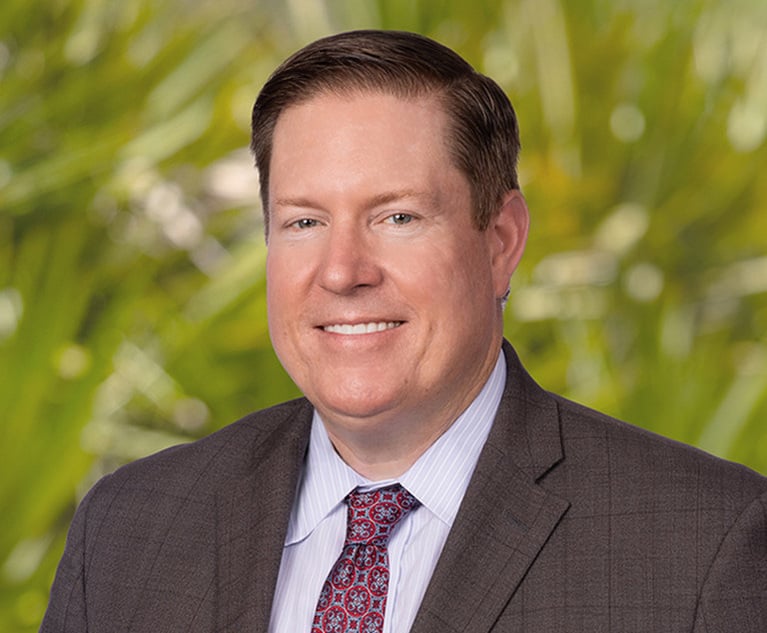Hurricane Michael Lays Bare Panhandle's Weaker Building Codes
Many structures did not withstand the fury of Hurricane Michael, which slammed into the area last week with winds of up to 155 mph, leaving acres of flattened houses and other buildings in its wake.
October 16, 2018 at 10:43 AM
5 minute read
 Furniture stands inside a damaged beach house after Hurricane Michael hit in Mexico Beach. Photographer: Zack Wittman/Bloomberg
Furniture stands inside a damaged beach house after Hurricane Michael hit in Mexico Beach. Photographer: Zack Wittman/Bloomberg
Unlike in South Florida, homes in the state's Panhandle did not have tighter building codes until just 11 years ago; it was once argued that acres of forests would provide the region with a natural barrier against the savage winds of a hurricane.
Many of those structures did not withstand the fury of Hurricane Michael, which slammed into the area last week with winds of up to 155 mph, leaving acres of flattened houses and other buildings in its wake before roaring across the Georgia border inland.
“We're learning painfully that we shouldn't be doing those kinds of exemptions,” said Don Brown, a former legislator from the Panhandle who now sits on the Florida Building Commission. “We are vulnerable as any other part of the state. There was this whole notion that the trees were going to help us, take the wind out of the storm. Those trees become projectiles and flying objects.”
Hurricane Andrew a generation ago razed Florida's most-populated areas with winds up to 165 mph, damaging or blowing apart more than 125,000 homes and obliterating almost all mobile homes in its path. The acres of flattened homes showed how contractors cut corners amid the patchwork of codes Florida had at the time. For example, flimsy particle board was used under roofs instead of sturdier plywood, and staples were used instead of roofing nails.
Since 2001, structures statewide must be built to withstand winds of 111 mph and up; the Miami area is considered a “high velocity hurricane zone” with much higher standards, requiring many structures to withstand hurricane winds in excess of 170 mph.
Though Michael's winds were particularly fierce, any boost in the level of safety requirements for builders could help homes better withstand hurricanes.
Tom Lee, a homebuilder and legislator, says past hurricanes have shown time and time again that the stricter codes help. He said after such previous storms, he could see during flyovers which homes were built before the new code.
“The structural integrity of our housing stock is leaps and bounds beyond what it was,” Lee said.
The codes call for shatterproof windows, fortified roofs and reinforced concrete pillars, among other specifications. But it wasn't until 2007 that homes built in the Panhandle more than 1 mile from shore were required to follow the higher standards. Hurricane Michael pummeled the region with devastating winds from the sea all the way into Georgia, destroying buildings more than 70 miles from the shoreline.
Gov. Rick Scott said it may be time for Florida to boost its standards, considered the toughest in the nation, even further.
“After every event, you always go back and look at what you can do better,” Scott said. “After Andrew, the codes changed dramatically in our state. Every time something like this happens, you have to say to yourself, 'Is there something we can do better?' ”
Mexico Beach, the Gulf Coast town destroyed by Michael, lacked a lot of new or retrofitted construction, said Craig Fugate, the former director of the Federal Emergency Management Agency and a former emergency management chief for the state of Florida. The small seaside community had a lot of older mobile homes and low-income year-round residents working in the commercial fishing and service industries.
“Quiet, idyllic, what I call 'Old Florida,' ” Fugate said. “This is not a bunch of high-rises or brand-new developments.”
Bill Herrle, who owned a house near the shoreline in Mexico Beach until it was destroyed by the storm, said he wasn't sure it made a difference when the homes there were built. He said the storm took out his house, built in the mid-1980s, as well as newer buildings put up recently.
“It wiped out both the older and newer homes. It looks like my entire street is razed,” said Herrle, who was not in Mexico Beach during the storm.
David Prevatt, an associate professor of civil and coastal engineering at the University of Florida, said in an email Thursday that drone footage of the devastation in Mexico Beach showed structural damage to roofs and exterior walls, and damaged rafters and trusses, “indicating the strength of the wind that caused those failures.”
Prevatt noted the damage could have occurred at wind speeds lower than the 155 mph that the National Hurricane Center reported at Michael's landfall. That is, the homes could have been peeling apart before the eye and the hurricane's strongest core winds came ashore.
Prevatt was preparing to lead a team to assess the damage. He said engineers will be asking how old the destroyed and damaged buildings were and under what version of the Florida building codes they were built. They also will be looking at the differences between the structures that survived and those that did not.
Gary Fineout reports for the Associated Press.
This content has been archived. It is available through our partners, LexisNexis® and Bloomberg Law.
To view this content, please continue to their sites.
Not a Lexis Subscriber?
Subscribe Now
Not a Bloomberg Law Subscriber?
Subscribe Now
NOT FOR REPRINT
© 2025 ALM Global, LLC, All Rights Reserved. Request academic re-use from www.copyright.com. All other uses, submit a request to [email protected]. For more information visit Asset & Logo Licensing.
You Might Like
View All
Mediating Community Association Disputes: Tips for Attorneys, and Their Clients
6 minute read

Cole, Scott & Kissane Keeps Transitioning More Resources Into Construction As Tort Reform Changes Loom
4 minute readTrending Stories
- 1Bribery Case Against Former Lt. Gov. Brian Benjamin Is Dropped
- 2‘Extremely Disturbing’: AI Firms Face Class Action by ‘Taskers’ Exposed to Traumatic Content
- 3State Appeals Court Revives BraunHagey Lawsuit Alleging $4.2M Unlawful Wire to China
- 4Invoking Trump, AG Bonta Reminds Lawyers of Duties to Noncitizens in Plea Dealing
- 522-Count Indictment Is Just the Start of SCOTUSBlog Atty's Legal Problems, Experts Say
Who Got The Work
J. Brugh Lower of Gibbons has entered an appearance for industrial equipment supplier Devco Corporation in a pending trademark infringement lawsuit. The suit, accusing the defendant of selling knock-off Graco products, was filed Dec. 18 in New Jersey District Court by Rivkin Radler on behalf of Graco Inc. and Graco Minnesota. The case, assigned to U.S. District Judge Zahid N. Quraishi, is 3:24-cv-11294, Graco Inc. et al v. Devco Corporation.
Who Got The Work
Rebecca Maller-Stein and Kent A. Yalowitz of Arnold & Porter Kaye Scholer have entered their appearances for Hanaco Venture Capital and its executives, Lior Prosor and David Frankel, in a pending securities lawsuit. The action, filed on Dec. 24 in New York Southern District Court by Zell, Aron & Co. on behalf of Goldeneye Advisors, accuses the defendants of negligently and fraudulently managing the plaintiff's $1 million investment. The case, assigned to U.S. District Judge Vernon S. Broderick, is 1:24-cv-09918, Goldeneye Advisors, LLC v. Hanaco Venture Capital, Ltd. et al.
Who Got The Work
Attorneys from A&O Shearman has stepped in as defense counsel for Toronto-Dominion Bank and other defendants in a pending securities class action. The suit, filed Dec. 11 in New York Southern District Court by Bleichmar Fonti & Auld, accuses the defendants of concealing the bank's 'pervasive' deficiencies in regards to its compliance with the Bank Secrecy Act and the quality of its anti-money laundering controls. The case, assigned to U.S. District Judge Arun Subramanian, is 1:24-cv-09445, Gonzalez v. The Toronto-Dominion Bank et al.
Who Got The Work
Crown Castle International, a Pennsylvania company providing shared communications infrastructure, has turned to Luke D. Wolf of Gordon Rees Scully Mansukhani to fend off a pending breach-of-contract lawsuit. The court action, filed Nov. 25 in Michigan Eastern District Court by Hooper Hathaway PC on behalf of The Town Residences LLC, accuses Crown Castle of failing to transfer approximately $30,000 in utility payments from T-Mobile in breach of a roof-top lease and assignment agreement. The case, assigned to U.S. District Judge Susan K. Declercq, is 2:24-cv-13131, The Town Residences LLC v. T-Mobile US, Inc. et al.
Who Got The Work
Wilfred P. Coronato and Daniel M. Schwartz of McCarter & English have stepped in as defense counsel to Electrolux Home Products Inc. in a pending product liability lawsuit. The court action, filed Nov. 26 in New York Eastern District Court by Poulos Lopiccolo PC and Nagel Rice LLP on behalf of David Stern, alleges that the defendant's refrigerators’ drawers and shelving repeatedly break and fall apart within months after purchase. The case, assigned to U.S. District Judge Joan M. Azrack, is 2:24-cv-08204, Stern v. Electrolux Home Products, Inc.
Featured Firms
Law Offices of Gary Martin Hays & Associates, P.C.
(470) 294-1674
Law Offices of Mark E. Salomone
(857) 444-6468
Smith & Hassler
(713) 739-1250







